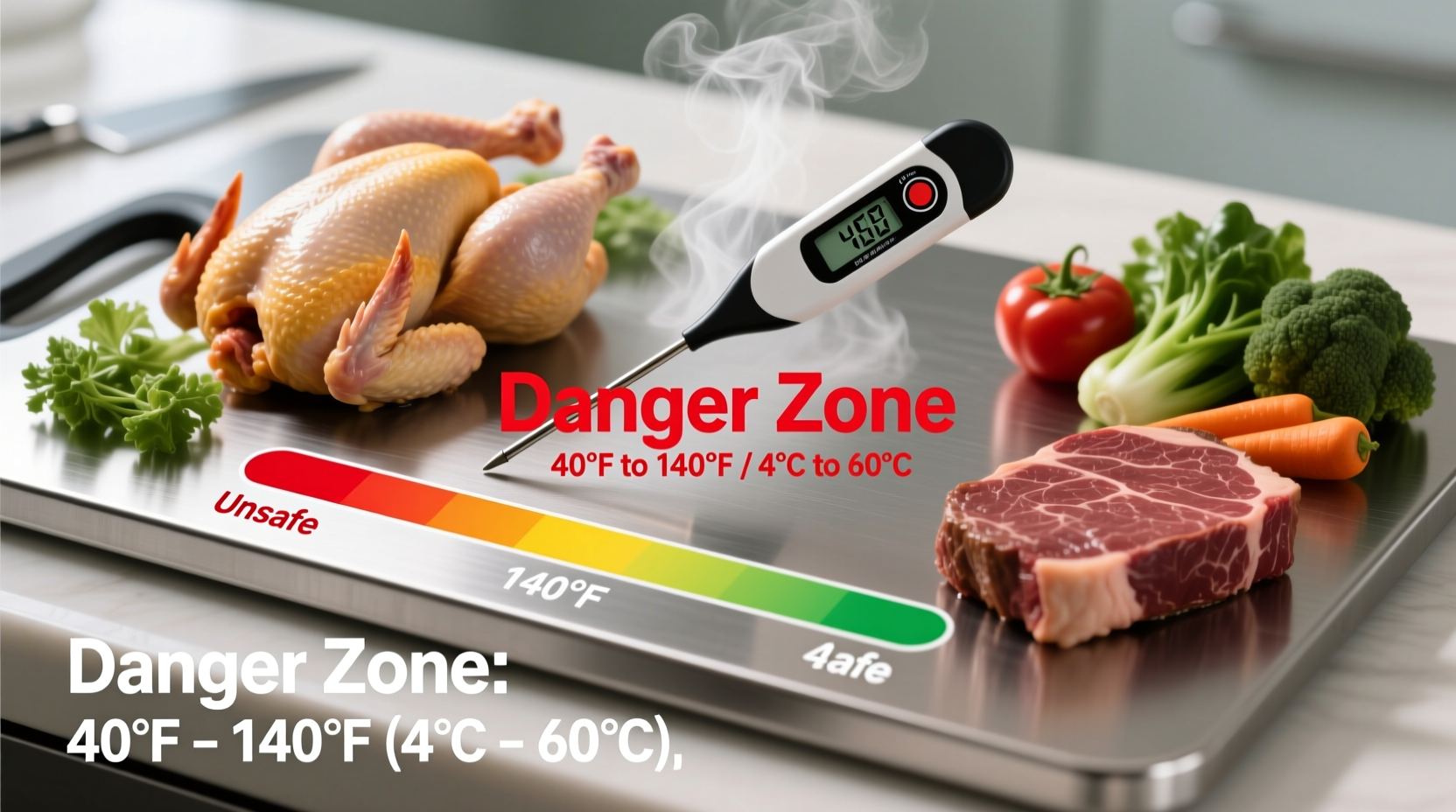The food danger zone is the temperature range between 40°F (4.4°C) and 140°F (60°C) where harmful bacteria multiply rapidly, potentially causing foodborne illness. Food should never remain in this range for more than 2 hours (1 hour if ambient temperature exceeds 90°F/32°C).
Understanding the food danger zone isn't just kitchen trivia—it's your first line of defense against foodborne illness that affects 48 million Americans annually according to the CDC. When you grasp these temperature boundaries, you transform from passive cook to active food safety guardian, protecting yourself and others from preventable illness.
Why the Danger Zone Matters More Than You Think
Within the danger zone temperature range, bacteria like Salmonella, E. coli, and Listeria don't just survive—they thrive. The USDA Food Safety and Inspection Service confirms that bacterial populations can double every 20 minutes under optimal conditions. That seemingly harmless plate of leftovers left on the counter could harbor millions of pathogens in just a few hours.
"Many home cooks don't realize that food safety isn't just about cooking temperatures—it's about the entire temperature journey from preparation to consumption," explains Antonio Rodriguez, culinary expert with professional kitchen experience. "The danger zone encompasses every moment food spends at unsafe temperatures, not just during cooking." 
The Science Behind Bacterial Multiplication
Bacteria require specific conditions to multiply rapidly. The danger zone provides the perfect storm:
- Moisture - Most foods contain sufficient water content
- Nutrients - Proteins and carbohydrates fuel bacterial growth
- Neutral pH - Many common foods provide ideal acidity levels
- Temperature - 40°F-140°F creates optimal metabolic conditions
The FDA Food Code specifies that time-temperature abuse occurs when potentially hazardous foods remain in the danger zone for cumulative periods exceeding safe limits. This isn't theoretical—each year, temperature abuse contributes to thousands of foodborne illness outbreaks documented by the CDC.
How Long Is Too Long? The Critical Time Limits
Understanding the relationship between time and temperature is crucial for food safety. The USDA provides clear guidelines:
| Ambient Temperature | Maximum Safe Time in Danger Zone | Scientific Basis |
|---|---|---|
| Below 90°F (32°C) | 2 hours | Allows for sufficient time to prepare, serve, and consume food while minimizing bacterial growth to safe levels |
| Above 90°F (32°C) | 1 hour | Higher ambient temperatures accelerate bacterial reproduction rates, requiring stricter time limits |
| During cooking | As needed to reach safe internal temperatures | Food passes through danger zone during heating, but continuous temperature rise prevents significant bacterial growth |
Practical Strategies to Stay Out of the Danger Zone
Knowledge alone won't keep your food safe—you need actionable techniques. Implement these evidence-based practices:
Cooking to Safety
Use a reliable food thermometer to verify internal temperatures. The USDA specifies minimum safe cooking temperatures:
- Poultry: 165°F (73.9°C)
- Ground meats: 160°F (71.1°C)
- Fish: 145°F (62.8°C) or until flesh flakes easily
- Beef, pork, veal, lamb steaks/roasts: 145°F (62.8°C) with 3-minute rest time
Cooling Hot Foods Properly
Rapid cooling prevents extended time in the danger zone. The FDA Food Code recommends:
- Divide large quantities into smaller, shallow containers
- Use an ice-water bath for rapid cooling
- Stir liquids frequently to release heat
- Cool from 135°F to 70°F within 2 hours, then to 41°F or below within an additional 4 hours
Hot Holding and Cold Storage
Maintain proper temperatures during service:
- Hot foods: Keep at 140°F (60°C) or above using warming trays, slow cookers, or chafing dishes
- Cold foods: Maintain at 40°F (4.4°C) or below using ice baths or refrigeration
- Refrigerator temperature: Verify with a thermometer (should be 40°F or below)
Special Considerations for Different Food Types
Not all foods behave the same in the danger zone. Understanding these nuances improves your food safety practices:
- High-risk foods - Meat, poultry, fish, eggs, dairy, and cooked starches support rapid bacterial growth
- Acidic foods - Foods with pH below 4.6 (like tomatoes, citrus) inhibit some pathogens but not all
- Dry foods - Items with low moisture content (crackers, pasta) have minimal bacterial growth risk
- Salt/sugar preserved foods - High concentrations create osmotic pressure that limits bacterial growth
The FDA's Food Code recognizes these differences in its classification of potentially hazardous foods, which require strict time-temperature control. This distinction matters because improper handling of high-risk foods accounts for most foodborne illness outbreaks.
Common Danger Zone Mistakes (And How to Avoid Them)
Even experienced cooks make these critical errors:
- The countertop cooling myth - Leaving hot food to cool at room temperature instead of using rapid cooling methods
- Thermometer neglect - Guessing temperatures rather than verifying with a calibrated thermometer
- Cross-contamination during temperature transitions - Using the same surfaces for raw and cooked foods during cooling/heating
- Improper hot holding - Assuming warming settings on appliances maintain safe temperatures (verify with thermometer)
"I've seen professional kitchens fail health inspections because staff assumed their equipment maintained proper temperatures," notes Rodriguez. "Regular thermometer verification is non-negotiable for food safety."
Your Food Safety Action Plan
Transform knowledge into practice with these immediate steps:
- Invest in two accurate food thermometers—one for cooking, one for refrigerator/freezer monitoring
- Create a kitchen temperature log to track refrigerator, freezer, and cooking temperatures
- Implement the two-hour rule consistently for all perishable foods
- Train everyone in your kitchen on danger zone principles and thermometer use
- Establish cooling protocols for large-batch cooking
Remember that food safety isn't about perfection—it's about consistent practices that significantly reduce risk. Each time you properly monitor temperatures, you're actively preventing potential illness.











 浙公网安备
33010002000092号
浙公网安备
33010002000092号 浙B2-20120091-4
浙B2-20120091-4